Look Beyond Plants for a Wonderful Winter Garden
When designing a landscape for year-round interest, people typically check their plant lists for a selection of evergreen trees and shrubs that offer a pleasing combination of foliage and texture. Frozen grasses and seed heads bring a sculptural quality to the winter garden, while berried stems and colorful twigs add a welcome splash of color when the garden turns into a monochromatic snowy world.
But as you look across your winter garden, where does your eye rest? Is there a focal point or two that cause the eye to linger or encourage you to don a warm coat and boots to explore up close? Certainly the beautiful mahogany peeling bark of the paperbark maple (Acer griseum) looks striking rising from a blanket of snow, as does a stand of redtwig dogwoods (Cornus sericea), but there are other ways to create a focal point in winter — by taking advantage of structures such as sheds, arbors and fences, as well as sculptures both large and small.
To be effective in this way, such pieces need to be clearly visible in winter, so their relationship with the surrounding plants needs careful planning. These focal points need to be framed by plants rather than smothered by them to create winter vignettes that will add drama to the bare-bones garden.
Here are some ideas to get you started.
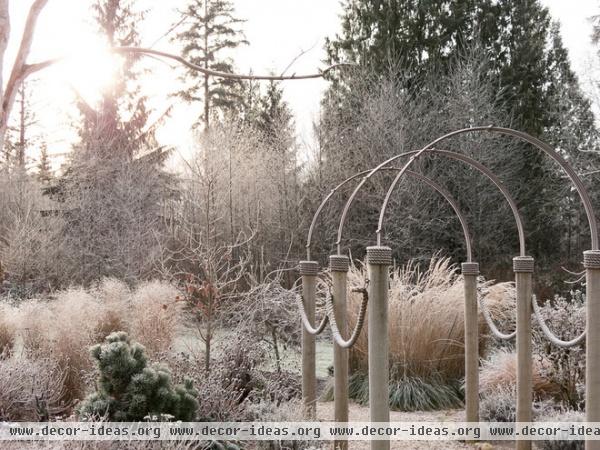
Arbors, archways and pergolas. This arbor is the entry point to a large mixed border; it’s composed of a trio of simple arches connected by swags of rope. While adding height and scale to the garden, this structure is transparent, allowing the plants beyond to be framed rather than obscured.
The temptation is to use such structures as a support for climbing roses or vines, yet this unique design would not have such a significant impact if it were covered in this way. The open silhouette would be lost, and the interesting combination of materials hidden beneath a tangle of stems.
Instead low-growing shrubs and perennials flank the pathway, framing the focal point rather than smothering it. In this frosty scene, the weathered wood and rope become a part of the monochromatic winter scene yet stand apart from it.
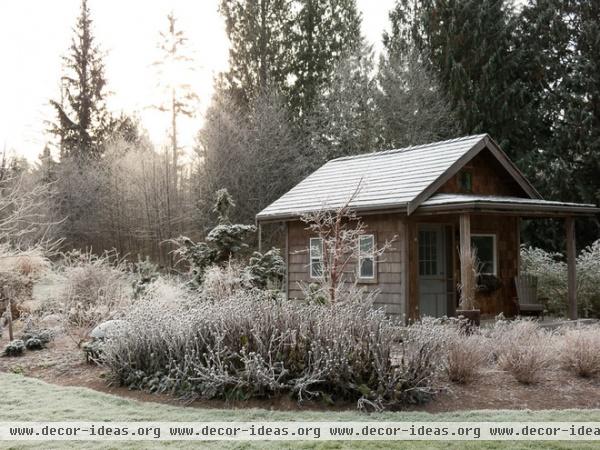
Cabins and garden sheds. Many gardens have a shed of some sort, perhaps for storing tools or potting up plants. My own shed-turned-cabin has served many purposes: a summer guesthouse, a writing studio, a place to overwinter frost-tender plants and even a registry office for our daughter’s garden wedding. Regardless of how you use yours, a shed is a significant structure that can become a winter focal point.
Unlike with the open arbor shown earlier, these solid walls obscure the garden beyond but can become a perfect screen against which to view wispy seed heads and grasses. Such fine textures tend to disappear into a hazy muddle in the garden, yet projected against the cabin walls, each detail is brought into focus.
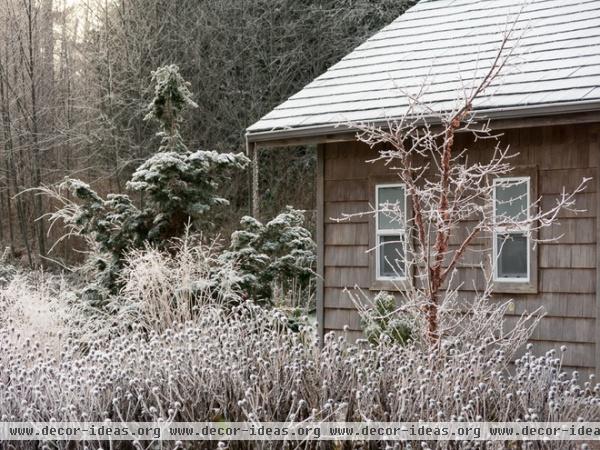
As with the arbor, the plantings have been kept low so that they frame the building rather than hide it. The exception is a paperbark maple, which acts as a punctuation point. Its peeling bark adds to the vignette, while its taller slender silhouette prevents the design from becoming monotonous.
Imagine this scene without the cabin and you are left with an interesting tapestry of shapes and textures. Yet with the structure, it’s a true winter garden with an enticing path drawing you toward an inviting focal point.
See more backyard escapes
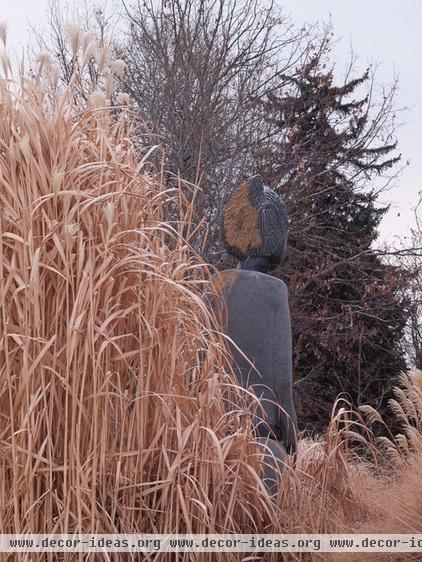
Sculptures and garden art. From large-scale installations by professional artists to smaller whimsical pieces at shows and craft fairs, we purchase sculptures and garden art because we fall in love with them — they speak to us in some way. So why hide them?
Place the artwork where you can enjoy it from inside the home on a cold winter day, while also considering its association with adjacent plants. These plants should enhance the sculpture, not compete with it or be an afterthought, as they are an integral part of the overall scene.
This is an example of a dramatic stone sculpture in the Denver Botanic Gardens. The figure has an imposing presence on its own, yet the tall stand of grasses set to one side increases its significance — especially in the otherwise bare winter landscape.
The juxtaposition of the cold, hard stone with the coarse, frozen grass, together with the subtle color echo between the tan blades and the sculpture, makes this an arresting focal point in winter — it will be equally impressive yet have quite a different feel the rest of the year.
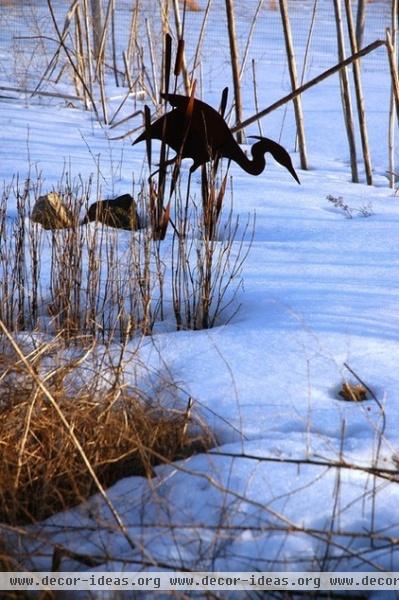
How often have you brought home a small piece of garden art and walked around the garden wondering where to put it before eventually inserting it into a “space”? While it may physically fit there, it may not be the ideal spot if the plants don’t relate to it in some way.
This simple heron looks like a dark shadow among the reeds, partially obscured from the world, just as we would expect to see it in the wild. It’s poised and ready to dive for its supper; we can imagine the fish swimming in the watery pool beneath the snow.
Careful placement is key to creating a natural scene. An evergreen hedge or a solid wall would neither have looked realistic nor have let the metal bird show up.
Many such pieces are easily moved, so do not be afraid to relocate them to a more suitable place for winter viewing, perhaps to create a focal point where previously there was none.
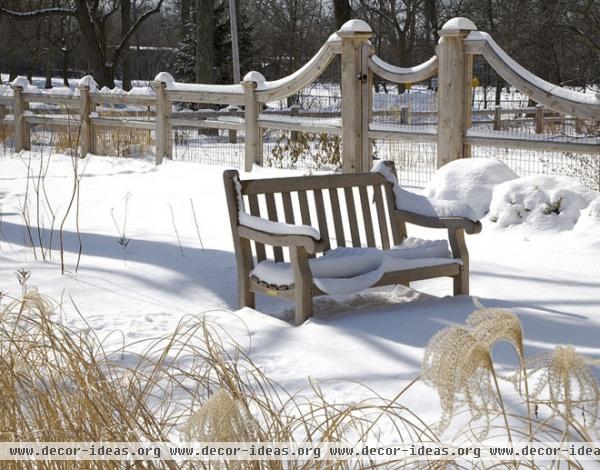
Fences and benches. Fences can do more than just mark property boundaries. Artistic pieces, such as this one, can become a design element in themselves. Standing in the open winter landscape, this unadorned swagged fence has a sculptural quality.
Likewise a bench, while functional in warmer months, still invites us outside even on a cold day and in the snow covered landscape becomes a focal point. Here the structures of the fence and the bench work together to create a winter vignette, softened in the foreground by pale, wispy grasses.
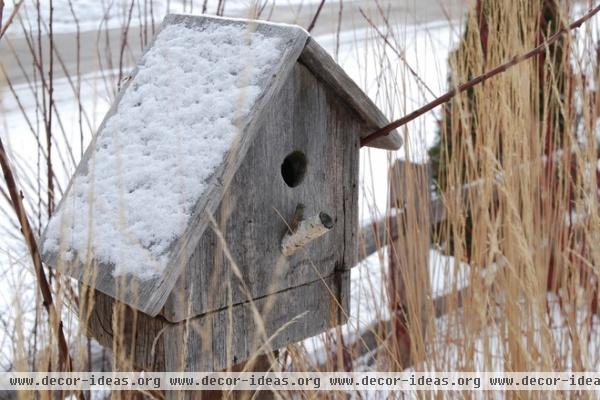
Birdhouses. Not all focal points have to be large or expensive. A simple weathered birdhouse can also capture attention if placed appropriately.
Whereas a birdhouse could become lost in the distance of a larger landscape, siting it close to the home, where it could be viewed through a window or at a garden entry point, would work well. It would also be beautiful in any small garden.
Once again the grasses play an important role, as they are a subtle framing yet allow the birdhouse to remain visible.
More: Inspiring Winter Scenes From the Denver Botanic Gardens












